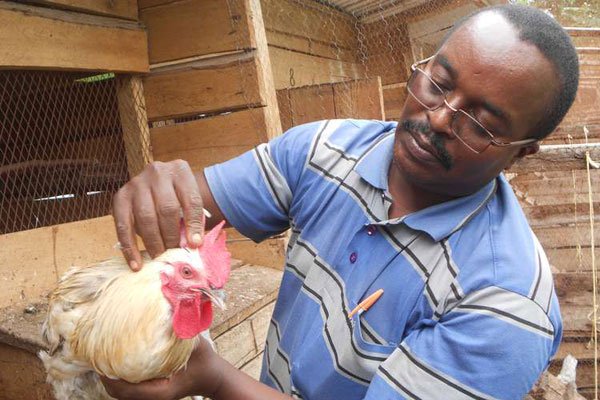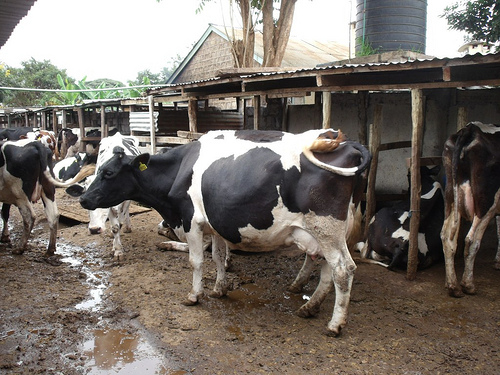From outside the gate of the farm in Mvungua village, Embu County, one can hear hens squawking and cockerels crowing.
Cows moo from another section of the half-acre farm owned by Roy Mugo. Mugo keeps over 600 chickens and does dairy farming in Kenya with four Friesian calves, having sold four others recently.
The former CEO of Murata Sacco Ltd in Murang’a County opted for early retirement in December 2013 to venture into farming.
A trip to Israel with friends mid that year had influenced his decision. “We visited different farms but one that stood out for me was a dairy goat farm owned by a family and it was earning millions of shillings every month,” he recounts.
While there, they were also given a lecture by a Jewish business expert named Yehuda on how to become a successful businessman.
“His lecture inspired me a lot that I listened to it over and over again when I returned to Kenya. And when I decided to start a farm, I named it after him in his honor.”
He started dairy farming in Kenya in January last year with a capital of Sh1.2 million from his pension.
“I used the money to buy six Friesian cows at a cost of Sh500,000 with the lowest going for Sh60,000 and the highest Sh90,000.”
A close friend also helped him buy 100 Kienyeji, Dorep and Kuroiler birds from a farm in Embu, which he added to 50 others he had been rearing. Each chick cost him Sh150, and out of the flock, 92 survived to maturity.
He spent the rest of the money to build cowsheds and coops for the cows and chickens.
“Since I had never seriously engaged myself in farming, I enrolled for a three-day training course at the Kenya Agricultural and Livestock Research Organisation Naivasha where I learned skills on poultry feeding, brooding, disease management, hatching and house construction,” recounts Mugo.
At the end of the training, he booked 200 Kari Kienyeji chicks from the research institute, which he received after 11 months. His brood has now risen to 600 chickens of the four breeds, 270 which are cockerels.
The poultry business has grown by leaps and bound to become his main source of income, earning him an average of Sh5,500 a day from selling eggs.
To curb diseases and increase productivity, he has built storied chicken coops, with the birds feeding on the lower part and resting in the upper.
“This ensures that the upper part remains clean as no water spills there or there is no dirt due to food remains.”
He further keeps each breed in its own cages to prevent interbreeding, which can lead to losing the original breeds
To farmer makes his own poultry feeds from wheat and maize bran, sunflower, soya, cotton seeds cake, fish meal, and vegetables like sukuma wiki he farms to ensure the chicken lays eggs with a more yellow yolk.
“I also mix the feeds with sand for grit, which helps in digestion and some fresh cow dung that provides the chickens with Vitamin B2 due to the green matter is eaten by the animals,” he says, adding he places the dung inside the cages for the chicken to scavenge on it and get some grains, which the cows could have fed on.
Mugo further adds Di-Calcium Phosphate (DCP) to the feeds to help strengthen their bones. For the layers, he adds crushed eggshells to strengthen their eggs shells and to reduce deficiencies.
The farmer collects about 270 eggs every day from his laying brood, selling each at Sh20.
He hatches some of the eggs in three incubators and sells day-old chicks at Sh100 each, a month old at Sh150 while two months go at Sh250.
He sells four months cockerels at Sh800 each and between Sh1,000 and Sh1,200 after they attain the age of six months depending on their size.
Doris Wambui, an agricultural expert from Wambugu Agricultural Centre in Nyeri, says rearing various breeds of birds helps farmers to attract different customers.
“Farmers who keep several breeds earn more cash especially if they are doing so to sell them for meat purposes. Interbreeding though may disadvantage the farmers as it tends to do away with original breeds.”
She adds that when fresh cow dung is left inside a basin for about two to three days, it develops maggots which when fed to chickens provides them with protein.
His dairy farming in Kenya business has not picked up yet years down the line. Mugo has engaged an agricultural expert to help him better it.
“After they calve-down, I will sell the original animals and remain with the calves, already I have sold four of my original cows and have remained with four calves, I plan to sell the remaining two immediately they wean their calves,” he says, noting the two cows that he milks produce an average of 12 pints of milk each, which he sells at Sh. 50 a litre.
In his dairy farming in Kenya, milk production has been low, according to Mugo, because he bought Friesian cows that were not of good quality.
“The mistake I did is to rely on my little knowledge of dairy farming and completely believe the seller while purchasing the cows. After research, I have realized the cows I started dairy farming in Kenya were not good.
It is important to involve dairy experts while purchasing cows, particularly for beginners,” says Mugo, who is now keeping a good record and insemination plan for his cow to improve them.
The farmer has been able to recoup his investment from poultry farming but the dairy farming has not earned him anything yet that is where he plowed most of his money. “I hope to start earning a profit in two years if all goes well.”








